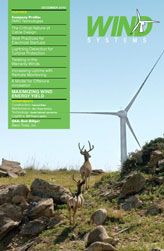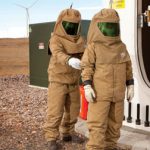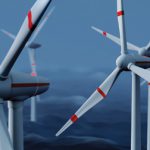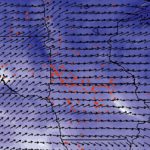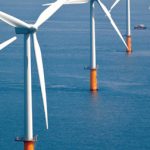As tall objects in a field, wind turbines make ideal targets for lightning strikes. Even more so as the application continues to grow as a serious source of new electricity generation: the total wind power capacity now operating in the United States is over 35,600 MW, which corresponds to the power usage of 9.7 million homes, according to the American Wind Energy Association (AWEA). Figure 1
As in any trade, system downtime and repairs must be minimized. This is where information about critical weather parameters becomes an important part of decision making. Wind, temperature, icing, lightning—relevant weather data can prove to be a vital asset for wind farm operators and other power companies alike. Ignoring these parameters can be a costly exercise. For example, the U.S. National Lightning Safety Institute states that at one wind farm in the southwest lightning damage alone exceeded $50,000 in the first year of operation, and at another 85 percent of the downtime experienced was lightning-related.
Wind turbines are designed with grounding systems to isolate the lightning current from sensitive electronic and mechanical components to ensure safety. Industry standards require wind turbines to withstand 98 percent of natural lightning strikes. Unfortunately, no lightning protection system is completely effective, so Vaisala lightning data is used by turbine manufacturers to validate that damage was truly caused by lightning before replacing blades under the terms of the warranty. Vaisala’s STRIKEnet® Internet service allows turbine manufacturers and wind farm owners to enter the geo-coordinates of the damaged turbine and search an extensive archive of cloud-to-ground lightning strikes for up to a 72 hour time window, generating an automated report of the lightning strikes in the vicinity. Depending on the terms of the agreement, turbine manufacturers or wind farm insurers will be responsible for repairing the damage. Additionally, Vaisala’s high quality real time and archive lightning data from the National Lightning Detection Network (NLDN®) is used by the Vaisala FALLS® application for extensive forensic analysis of faults and identifying lightning strokes which have caused outages or damage to transmission lines.
Lightning is also a challenge to traditional energy and power industries. High-current lightning strikes are a significant threat to the dependability of electric power transmission, because they can cause severe damage to power lines. Being able to detect and locate these events means savings in both time and money as the fault locations can be found more quickly, and electricity can be re-routed to a different path. Recent findings in Japan show an encouraging future trend in lightning detection for power companies and demonstrate the value of accurate and timely weather data in decision-making.
Significant R&D Achievements
Lightning locating systems provide valuable information to a wide variety of applications. The demand for both data quality and the range of cloud-to-ground lightning parameters is highest for forensic applications within the electric utility industry. For years the research and operational communities within this industry in Japan have pointed out a limitation of these systems in the detection and location of damaging (high-current and large charge transfer) lightning flashes during the winter months. Most of these flashes appear to be upward-connecting discharges, frequently referred to as “ground-to-cloud” flashes [1]. Figure 2
Lightning events along the coast of the Sea of Japan during the winter months emit particularly different waveforms than the majority of other lightning events, which makes them hard to detect or classify properly. To address this problem Vaisala has worked together with Tohoku Electric Power Company and Sankosha Corporation to develop improved lightning sensor software. Tohoku Electric supplies electricity to approximately 7.7 million customers throughout the seven prefectures of the Tohoku region. The company’s electric power sales amount to over 81,101 kWh, ranking it fifth among the 10 Japanese electric power companies. Sankosha Corporation has been supplying Vaisala lightning detection systems to the electric power companies in Japan for more than 25 years. Sankosha engineers install and maintain about 100 lightning sensors operating in Japan. They work closely with Vaisala engineers and scientists to make sure that networks are operating properly and network operators take advantage of new technologies as they become available.
The result of the joint R&D effort is the latest software for the Vaisala Thunderstorm CG Enhanced Lightning Sensor LS7001, which delivers double the detection accuracy of high peak current winter lightning discharges compared to older sensors. The new sensor is able to continuously sample and process detected signals eliminating the dead time problems of previous sensor generations. Enhanced self-test and calibration capabilities permit the simulation of more complex waveforms and help achieve a significant improvement in stroke time measurements.
As a part of the cooperative research project, a six sensor network of the new sensors was deployed in the Tohoku region during the 2009/2010 winter lightning season. Data from Lightning Electromagnetic Pulse (LEMP) recording equipment operated by Tohoku Electric and information from lightning related failures in Tohoku’s transmission line systems demonstrated significant improvements in lightning detection performance. This was achieved by studying electromagnetic waveforms generated by winter lightning and then developing new parameters for their detection. “Lightning detection information is extremely important in the operation and maintenance of our electric power transmission and distribution systems,” according to Noriyasu Honma from Tohoku’s Electricity Technology Section. “Improvement in our ability to detect high current winter lightning events is a critical step forward.” Figure 3
The project in Japan will continue through the 2011 winter lightning season. The algorithm updates employed in the reprocessing will be implemented in sensor software, which will be downloadable into most existing Vaisala LS sensors, making improved detection performance available for energy and power industries around the world.
Features and Benefits
The LS7001 is a compact, lightweight sensor with optional indoor mounting capability that detects low frequency (LF) signals using magnetic direction finding combined with time-of-arrival technology to deliver higher detection efficiency, location accuracy, and redundancy than any other method for detecting cloud-to-ground lightning strokes. The LS7001 is a cost-effective solution for customers demanding high reliability, ease of installation, and ease of maintenance. Features and benefits include:
• Cloud-to-ground lightning detection for the most accurate lightning location and calibrated parameters;
• Cloud-to-ground lightning of greater than 95 percent network detection efficiency;
• Detects up to 30 percent of cloud lightning for early thunderstorm identification;
• Detects cloud-to-ground lightning at long ranges (>1500 kilometers);
• Calibrated parameters for cloud-to-ground lightning: time, location, amplitude, polarity;
•Third party validated 250 meter median location accuracy for cloud-to-ground lightning strokes;
•New efficient lightweight electronics module allows for ease of installation and maintenance;
• Sensor can be installed separately from antenna in remote severe weather locations;
• Compatible with predecessors Vaisala IMPACT and Vaisala LPATS sensors;
• Available in AC and DC versions.
Precise Weather Knowledge
Wind turbine manufacturers and wind farm operators require high quality environmental measurement systems to maximize performance, support safe operations, and fulfill industry standards. Intelligent environmental measurements can be used in control systems, for example, improving community acceptance of wind farms by dimming obstruction lights in clear weather and getting field service teams to safe ground before thunderstorms arrive. Turnkey atmospheric observation networks can provide that significant advantage to save millions of dollars, combining wind speed predictions with other business-critical environmental data.



















